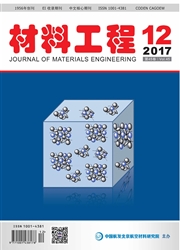

 中文摘要:
中文摘要:
在进料速度0.5mm·S^-、拉拔速度0.67-1.OOmm·S^-1、加热温度600-800℃的条件下,对QSi3-1硅青铜线材进行了无模拉拔实验,研究了无模拉拔工艺与QSi3-1硅青铜的显微组织和力学性能的关系。结果表明:在拉拔速度和断面收缩率相同的条件下,加热温度越高,无模拉拔成形结束后硅青铜晶粒的平均尺寸越大;当加热温度一定时,拉拔速度越高,硅青铜晶粒就越细小。无模拉拔成形硅青铜的硬度及抗拉强度随着加热温度的升高而逐渐降低,随着拉拔速度的升高而略有上升;在加热温度较低的条件下,抗拉强度下降明显,当加热温度升高到一定程度后,抗拉强度下降缓慢。无模拉拔成形过程中QSi3-1硅青铜的晶粒经历了变形细化及后续高温状态下的晶粒相互吞并长大两个过程。
 英文摘要:
英文摘要:
QSi3-1 silicon bronze alloy wires were processed by dieless drawing with the feeding speed of 0.5mm· s^-1, the drawing speed of 0. 67-1. 00mm · s^-1 and the heating temperature of 600-800℃. Effects of drawing speed and heating temperature on microstructure and mechanical properties of the alloy were investigated. The results show that the average grain size of the alloy after dieless drawing is larger at a high heating temperature when the drawing speed and area reduction are given, while it is finer at a high drawing speed when the heating temperature is constant. The hardness and tensile strength of the alloy decrease rapidly at first and then slowly with the increase of heating temperature. Meanwhile, they increase slightly with increasing the drawing speed. The grains of the alloy undergo deformation refinement and subsequently swallowing up each other at a high temperature during dieless drawing process.
 同期刊论文项目
同期刊论文项目
 同项目期刊论文
同项目期刊论文
 Room temperature tensile property and fracture behavior of CuNi10Fe1Mn alloy rods produced by OCC pr
Room temperature tensile property and fracture behavior of CuNi10Fe1Mn alloy rods produced by OCC pr Effects of solidification parameters on microstructure and mechanical properties of continuous colum
Effects of solidification parameters on microstructure and mechanical properties of continuous colum 期刊信息
期刊信息
